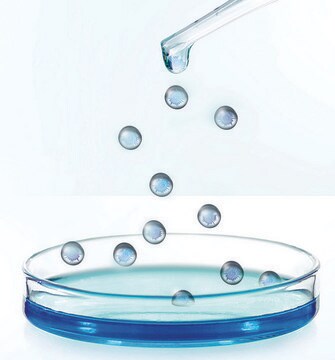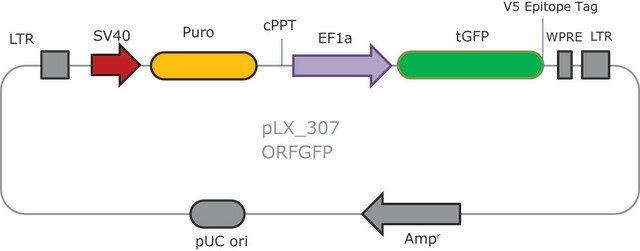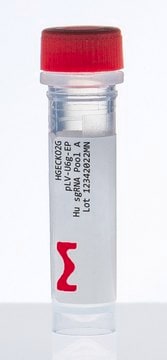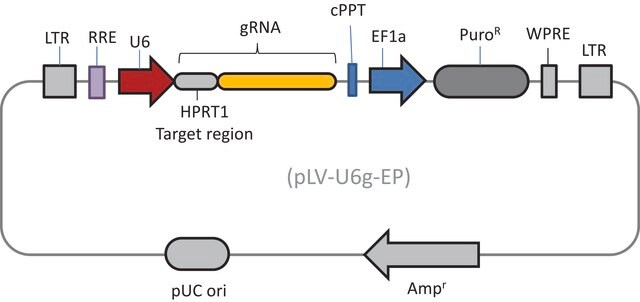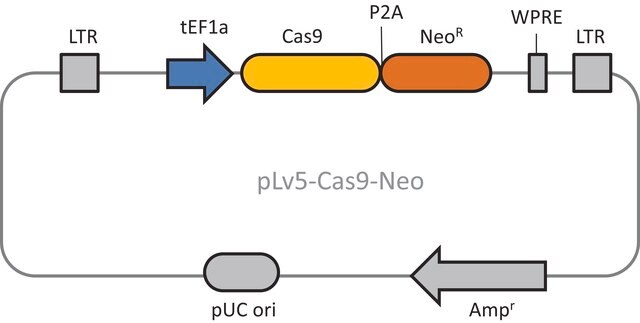HWGCRISPR
Sigma Whole Human Genome Lentiviral CRISPR Pool
About This Item
Produits recommandés
Conditionnement
pkg of 8x25 μL (vials)
Niveau de qualité
Concentration
5x108 VP/ml (via p24 assay)
Application(s)
CRISPR
Conditions d'expédition
dry ice
Température de stockage
−70°C
Catégories apparentées
Description générale
Application
Actions biochimiques/physiologiques
Caractéristiques et avantages
- Use CRISPR nucleases to knockout protein-coding genes to assess their function
- Efficiently screen the whole human genome (16,000+ genes) at the bench-top without robotics or specialized equipment
- Increased flexibility consisting of 8 subpools at 23,000 clones per pool (184,000 clones total), from the previous 2 subpools (Gecko v2)
- Expanded gRNA coverage at 10 gRNAs per gene, from the previous 6 gRNAs per gene (Gecko v2)
- Numerous built-in enrichment and depletion controls allows researchers to confidently gauge the success of their pooled screening experiments
- 2 Vector System (pools are gRNA-only, Cas9 sold separately)
- Ease of optimization: Utilizes same vector system as Gecko v2 allowing for optimization one for both systems
- Minimize off-targeting: stringent gRNA design and tiling rules
Notes préparatoires
Prior to performing a library-scale screening, two preliminary experiments must be conducted: (1) determine the sensitivity of target cell type to puromycin (kill curve), and (2) determine the functional titer of the lentivirus in your cell type by completing a colony-forming assay (measured in CFU/ml). The calculation of MOI (multiplicity of infection) should be based on the value of CFU. Different cell types vary in transduction efficiency and different lentiviral constructs do not behave identically, so it is critical to optimize your experimental conditions with control lentiviral CRISPR clones (available from Sigma) prior to performing your pooled experiment.
Autres remarques
Informations légales
Code de la classe de stockage
12 - Non Combustible Liquids
Classe de danger pour l'eau (WGK)
WGK 3
Point d'éclair (°F)
Not applicable
Point d'éclair (°C)
Not applicable
Certificats d'analyse (COA)
Recherchez un Certificats d'analyse (COA) en saisissant le numéro de lot du produit. Les numéros de lot figurent sur l'étiquette du produit après les mots "Lot" ou "Batch".
Déjà en possession de ce produit ?
Retrouvez la documentation relative aux produits que vous avez récemment achetés dans la Bibliothèque de documents.
Les clients ont également consulté
Articles
Our lentiviral vector systems are developed with enhanced safety features. Numerous precautions are in place in the design of our lentiviruses to prevent replication. Good handling practices are a must.
Get tips for handling lentiviruses, optimizing experiment setup, titering lentivirus particles, and selecting helpful products for transduction.
Protocoles
You are not alone designing successful CRISPR, RNAi, and ORF experiments. We were the first company to commercially offer lentivirus versions of targeted genome modification technologies and has the expertise and commitment to support new generations of scientists.
FACS (Fluorescence-Activated Cell Sorting) provides a method for sorting a mixed population of cells into two or more groups, one cell at a time, based on the specific light scattering and fluorescence of each cell. This method provides fast, objective, and quantitative recording of fluorescent signals from individual cells.
Notre équipe de scientifiques dispose d'une expérience dans tous les secteurs de la recherche, notamment en sciences de la vie, science des matériaux, synthèse chimique, chromatographie, analyse et dans de nombreux autres domaines..
Contacter notre Service technique
